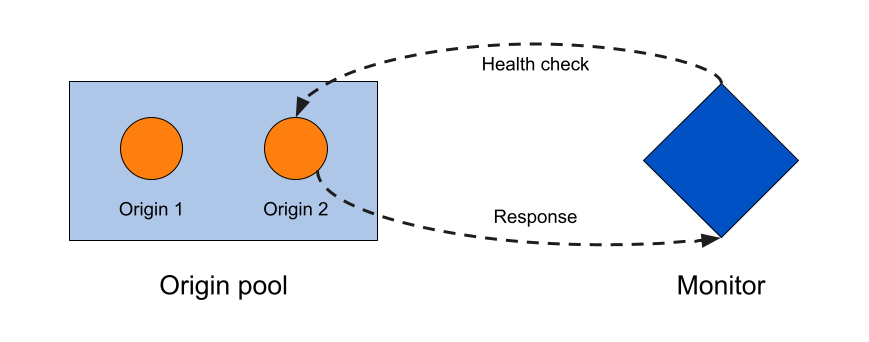How origins and pools become unhealthy
When we talk about dynamic load balancing, that means your load balancer only directs requests to servers that can handle the traffic.
But how does your load balancer know which servers can handle the traffic? We determine that through a system of monitors, health checks, and origin pools.
Components
Dynamic load balancing happens through a combination of:
- Origin pools : Contain one or more origin servers.
- Monitors : Are attached to individual origin servers and issue health checks at regular intervals.
- Health checks: Are issued by a monitor at regular interval and — depending on the monitor settings — return a pass or fail value to make sure an origin is still able to receive traffic.

How an origin becomes unhealthy
The purpose of each health check is to determine whether an origin has changed status from the previous health check.
A health check will fail if one of the following conditions are met:
- The health check exceeds the duration specified in the monitor’s Timeout field (and does so more than the specified number of Retries).
- The origin does not return the Expected codes or Response body specified in the monitor’s configuration.
For each option selected in a pool’s Health Check Regions, Cloudflare sends health checks from three separate data centers in that region.

If the majority of data centers for that region pass the health checks, that region is considered healthy. If the majority of regions is healthy, then the origin itself will be considered healthy.
For greater accuracy and consistency when changing origin health status, you can also set the consecutive_up and consecutive_down parameters via the Create Monitor API endpoint. To change from healthy to unhealthy, an origin will have to be marked healthy a consecutive number of times (specified by consecutive_down). The same applies — from unhealthy to healthy — for consecutive_up.
How a pool becomes unhealthy
When an individual origin becomes unhealthy , that may affect the health status of any associated origin pools (visible in the dashboard):
- Healthy: All origins are healthy.
- Degraded: At least one origin is unhealthy, but the pool is still considered healthy and could be receiving traffic.
- Critical: The pool has fallen below the number of available origins specified in its Health Threshold and will not receive traffic from your load balancer (unless other pools are also unhealthy and this pool is marked as the Fallback Pool ).
- Health unknown: There are either no monitors attached to pool origins or the monitors have not yet determined origin health.
- No health: Reserved for your load balancer’s Fallback Pool .
Traffic distribution
When a pool reaches Critical health, your load balancer will begin diverting traffic according to its Traffic steering policy :
Off:
- If the active pool becomes unhealthy, traffic goes to the next pool in order.
- If an inactive pool becomes unhealthy, traffic continues to go to the active pool (but would skip over the unhealthy pool in the failover order).
All other methods: Traffic is distributed across all remaining pools according to the steering policy.
Fallback pools
Because a load balancer Fallback Pool is meant to be a pool of last resort, it’s health is not taken into account when directing traffic.
If all pools in a Load Balancer are manually disabled or unhealthy, traffic will always go to the fallback pool.
How a load balancer becomes unhealthy
When one or more pools become unhealthy, your load balancer might also show a different status in the dashboard:
- Healthy: All pools are healthy.
- Degraded: At least one pool is unhealthy, but traffic is not yet going to the Fallback Pool .
- Critical: All pools are unhealthy and traffic is going to the Fallback Pool .
If a load balancer reaches Critical health and the pool serving as your fallback pool is also disabled:
- If Cloudflare proxies your hostname, you will see a 530 HTTP/1016 Origin DNS failure.
- If Cloudflare does not proxy your hostname, you will see the SOA record.